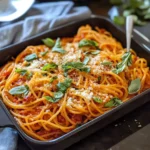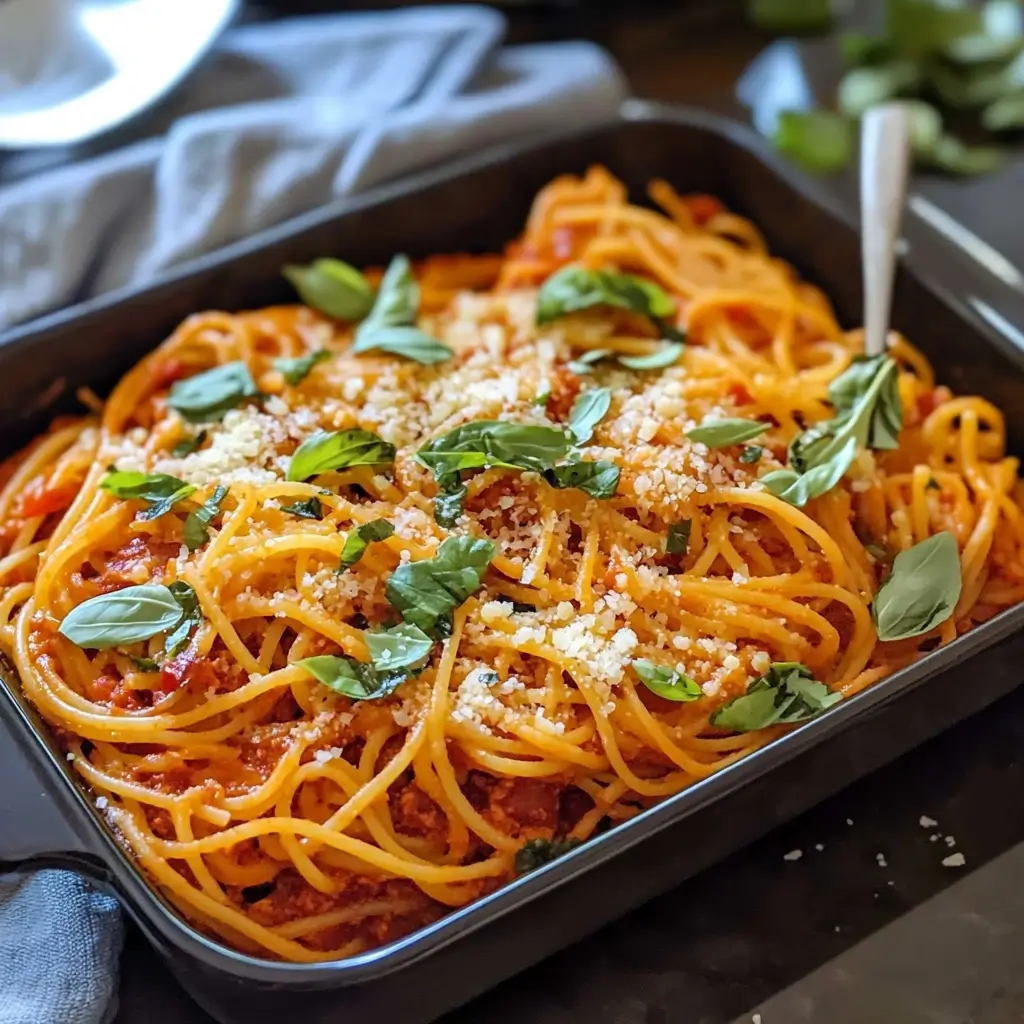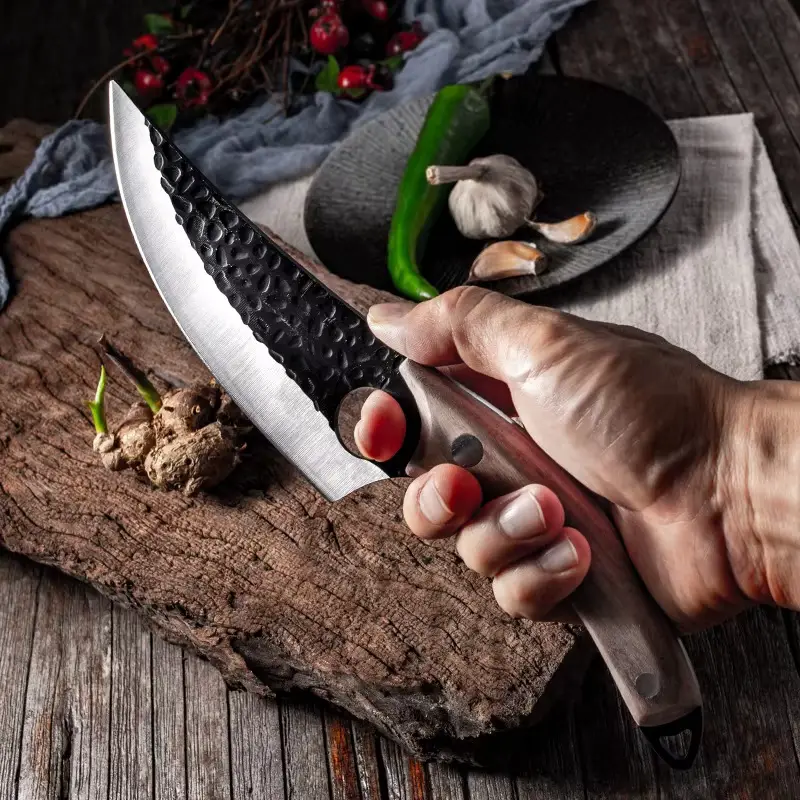There’s nothing quite like the aroma of a home-cooked meal wafting through the house, especially when it promises the comforting embrace of pasta. Recently, I stumbled upon a recipe that has completely redefined my weeknight dinner routine: the Arrabiata Sauce Spaghetti Bake. Let me tell you, this isn’t your grandma’s spaghetti bake – unless your grandma is a culinary genius with a penchant for spicy, savory Italian flavors! From the moment I pulled this bubbling, cheesy masterpiece from the oven, I knew we were in for a treat. The vibrant red sauce, punctuated with flecks of chili and fragrant herbs, promised a depth of flavor that exceeded expectations. My family, a mix of spice enthusiasts and comfort food aficionados, devoured every last bite. Even my picky eaters, who usually approach new dishes with suspicion, were asking for seconds. The creamy arrabiata sauce, baked to perfection with al dente spaghetti and a generous blanket of Parmesan, created a symphony of textures and tastes that is both sophisticated and utterly satisfying. This recipe has become a fast favorite in our household, and I’m thrilled to share it with you. If you’re looking for a dinner that’s easy to prepare, bursting with flavor, and guaranteed to impress, look no further than this incredible Arrabiata Sauce Spaghetti Bake. Get ready to experience spaghetti bake like never before!
Ingredients
This recipe is all about fresh, flavorful ingredients that come together to create a truly exceptional dish. Here’s everything you’ll need to make your own Arrabiata Sauce Spaghetti Bake:
- 1 whole garlic bulb: Don’t be intimidated by using a whole bulb of garlic! Roasting it whole mellows the garlic’s pungent flavor, transforming it into a sweet, creamy, and utterly delectable component of the arrabiata sauce. Roasting garlic this way infuses the entire sauce with a subtle, complex garlic essence that is far superior to using minced or jarred garlic.
- 32 ounces cherry tomatoes: Cherry tomatoes are the star of our arrabiata sauce. Their natural sweetness intensifies as they roast, creating a vibrant and juicy base for the sauce. Using cherry tomatoes ensures a bright, fresh flavor that canned tomatoes simply can’t replicate. Look for ripe, plump cherry tomatoes for the best results.
- 1 medium shallot, diced: Shallots bring a delicate, slightly sweet onion flavor that complements the roasted garlic and tomatoes beautifully. They are less pungent than yellow onions and add a layer of sophistication to the sauce’s flavor profile. Dicing the shallot ensures it cooks evenly and blends seamlessly into the sauce.
- 1 teaspoon oregano: Dried oregano is a classic Italian herb that lends its distinctive, slightly peppery and earthy notes to the arrabiata sauce. It provides a foundational herbal aroma that enhances the overall flavor complexity. Make sure your oregano is fresh for the best potency.
- 1 teaspoon thyme: Thyme adds a subtle, earthy, and slightly minty flavor that complements the oregano and other herbs in the sauce. It adds depth and warmth, creating a well-rounded herbal profile. Like oregano, ensure your thyme is fresh for optimal flavor.
- ½ cup loosely packed fresh basil: Fresh basil is added at the beginning of the roasting process, allowing its fragrant oils to infuse the tomatoes and garlic. Basil contributes a sweet, peppery, and slightly anise-like flavor that is quintessential to Italian cuisine and elevates the freshness of the arrabiata sauce. Loosely packed ensures you are using the correct volume of leaves without overpacking.
- 3 teaspoons crushed red pepper flakes, or to taste: Arrabiata means “angry” in Italian, and this sauce gets its name from the fiery kick of crushed red pepper flakes. The amount listed here is a starting point; adjust to your spice preference. For a milder sauce, reduce the amount, and for a more intense heat, add more. The red pepper flakes provide not only heat but also a subtle fruity and slightly smoky flavor.
- 3 Tablespoons extra virgin olive oil: Extra virgin olive oil is crucial for roasting the vegetables and creating a rich, flavorful sauce. It helps to caramelize the tomatoes and garlic, bringing out their natural sweetness and depth of flavor. Use a good quality extra virgin olive oil for the best taste and health benefits.
- Salt to taste: Salt is essential for enhancing the flavors of all the ingredients. Season generously during the roasting process and again when blending the sauce. Taste and adjust as needed to achieve the perfect balance of flavors. Kosher salt or sea salt are recommended for their clean flavor.
- Black pepper to taste: Freshly ground black pepper adds a subtle warmth and depth to the sauce. Season generously along with the salt during roasting and adjust to taste. Freshly ground pepper offers a more vibrant and aromatic flavor compared to pre-ground pepper.
- 1 pound Barilla spaghetti noodles: Barilla spaghetti noodles are a classic choice for pasta bakes, known for their consistent quality and al dente texture when cooked properly. You can use other brands of spaghetti, but ensure they are good quality and cook to al dente. Spaghetti is the perfect shape to hold onto the rich arrabiata sauce.
- ¼ cup heavy cream: Heavy cream adds a luxurious richness and creaminess to the arrabiata sauce, mellowing out the heat and creating a smoother, more decadent texture. It balances the acidity of the tomatoes and ties all the flavors together. For a lighter option, you can use half-and-half, but heavy cream will provide the richest result.
- ½ cup grated Parmesan cheese: Parmesan cheese is a hard, salty Italian cheese that adds a savory, umami-rich flavor to the spaghetti bake. It melts beautifully in the oven, creating a golden, cheesy crust that is irresistible. Use freshly grated Parmesan for the best flavor and melting quality; pre-grated Parmesan often contains cellulose and doesn’t melt as well.
Instructions
Making this Arrabiata Sauce Spaghetti Bake is surprisingly easy, even though the end result tastes incredibly sophisticated. Follow these step-by-step instructions to create your own culinary masterpiece:
- Preheat the oven to 425 degrees Fahrenheit. Starting with a hot oven is crucial for roasting the vegetables properly. Preheating ensures the oven is at the correct temperature when you place the baking dish inside, allowing the tomatoes and garlic to roast evenly and develop their caramelized flavors. Make sure your oven reaches the set temperature before proceeding.
- Peel the outer layers of the whole head of garlic, making sure to leave the garlic cloves intact. Removing the papery outer layers of the garlic bulb allows the heat to penetrate the cloves and roast them evenly. Leaving the cloves intact inside the bulb is essential for roasting; this method steams the garlic within its own skin, resulting in soft, sweet, and creamy roasted garlic cloves. Don’t peel individual cloves, just the outer papery layers.
- In a 13×9 baking dish, add the cherry tomatoes, diced shallot, oregano, thyme, basil, and crushed red pepper. A 13×9 inch baking dish provides ample space for the vegetables to roast without overcrowding, ensuring they cook evenly. Distributing the cherry tomatoes, shallot, oregano, thyme, basil, and crushed red pepper in the dish at this stage allows their flavors to meld and infuse as they roast together.
- Place the head of garlic in the center of the baking dish. Positioning the garlic bulb in the center ensures it roasts evenly and its flavor diffuses throughout the tomato mixture as it cooks. The garlic bulb will become the heart of the flavor base for the arrabiata sauce.
- Drizzle with extra virgin olive oil, and season with salt and pepper to taste. Drizzling with olive oil coats the vegetables, helping them to roast and caramelize beautifully. Olive oil also adds richness and flavor to the sauce. Seasoning with salt and pepper at this stage enhances the natural flavors of the vegetables and herbs as they roast. Be generous with your seasoning, as it will be the primary flavor base for the sauce.
- Bake for 40-45 minutes or until tomatoes burst and garlic is nice and tender. Roasting at 425°F for 40-45 minutes allows the tomatoes to burst and release their juices, concentrating their sweetness and flavor. The garlic will become soft, creamy, and easily squeezable from its skin. Keep an eye on the baking dish; the tomatoes should be visibly bursting and the garlic should yield easily to gentle pressure. The aroma filling your kitchen will be incredibly enticing!
- In the meantime, cook the pasta according to the package instructions until al dente. Reserve 1 cup pasta water. Cooking the spaghetti while the sauce roasts is an efficient way to save time. Cook the pasta to al dente, meaning “to the tooth,” which is slightly firm and not mushy. This is crucial because the pasta will continue to cook slightly in the oven during the baking process. Reserving 1 cup of pasta water is essential; the starchy water will help to emulsify the sauce and create a silky smooth texture when combined with the pasta. Don’t discard the pasta water!
- Remove the tomato mixture from the oven and let cool slightly. Transfer to a high-speed blender with the heavy cream. Blend until smooth. Letting the roasted tomato mixture cool slightly prevents splattering when blending hot liquids. Transferring the mixture to a high-speed blender ensures a completely smooth and creamy arrabiata sauce. Add the heavy cream at this stage to incorporate richness and mellow the heat. Blend until the sauce is velvety smooth and all the ingredients are fully incorporated.
- Transfer to a pot with the cooked pasta, Parmesan cheese, and pasta water, if needed. Stir to combine. Pour the blended arrabiata sauce into a large pot or Dutch oven. Add the cooked spaghetti and grated Parmesan cheese. The Parmesan will melt into the hot sauce, adding a savory and cheesy element. Gradually add the reserved pasta water, a little at a time, while stirring. The pasta water helps to thin the sauce to the desired consistency and create a glossy, emulsified sauce that clings beautifully to the spaghetti. You may not need to use all the pasta water; add just enough to achieve a creamy, saucy consistency.
- Serve warm. Serve the Arrabiata Sauce Spaghetti Bake immediately while it’s hot and the sauce is creamy and the Parmesan is melted. Garnish with fresh basil leaves or extra Parmesan cheese for an elegant touch. This dish is best enjoyed fresh and hot, but leftovers can be stored and reheated.
Nutrition Facts
This nutritional information is an estimate and can vary based on specific ingredients and portion sizes. It’s always best to calculate nutritional information based on the exact brands and quantities of ingredients you use.
Servings: 4 servings
Approximate Calories per serving: 650-750 calories (This is an estimate and can vary significantly based on portion size and specific ingredient brands used, especially the amount of olive oil and Parmesan cheese.)
- Macronutrients (per serving, approximate):
- Protein: 25-30g
- Fat: 30-35g (This will vary depending on the amount of olive oil and heavy cream used)
- Carbohydrates: 70-80g
- Note: This recipe provides a good source of carbohydrates, some protein, and healthy fats from olive oil. It is important to consider portion sizes and balance this meal within your overall dietary needs. For a lighter version, you could reduce the amount of olive oil and heavy cream, or use whole wheat pasta.
Preparation Time
This recipe is wonderfully efficient, making it perfect for busy weeknights or when you want a delicious meal without spending hours in the kitchen.
- Prep Time: 10 minutes
- This includes peeling the garlic, dicing the shallot, measuring out the herbs and spices, and gathering all the ingredients.
- Cook Time: 45 minutes
- This encompasses the 40-45 minutes of roasting time for the vegetables and the approximately 10 minutes to cook the spaghetti. The pasta cooking time may vary slightly depending on the brand and type of spaghetti.
- Total Time: 55 minutes
- From start to finish, you can have this flavorful Arrabiata Sauce Spaghetti Bake on the table in under an hour, making it a fantastic option for a satisfying and relatively quick dinner.
How to Serve
This Arrabiata Sauce Spaghetti Bake is a complete meal in itself, but you can elevate the dining experience and create a more balanced and satisfying spread by serving it with complementary sides. Here are some delicious ways to serve this dish:
- Classic Crusty Bread: No Italian meal is complete without crusty bread for soaking up all that delicious sauce. Serve with a warm loaf of Italian bread, baguette, or sourdough. Garlic bread would be an especially decadent pairing.
- Side Salad: A fresh, vibrant side salad provides a welcome contrast to the richness of the spaghetti bake.
- Simple Green Salad: A simple salad with mixed greens, a light vinaigrette, and maybe some cherry tomatoes and cucumbers will cut through the richness of the pasta.
- Caesar Salad: A classic Caesar salad with crisp romaine lettuce, creamy dressing, croutons, and Parmesan cheese is another excellent choice.
- Arugula Salad with Lemon and Parmesan: The peppery arugula, bright lemon dressing, and shaved Parmesan create a refreshing and flavorful salad that complements the spicy arrabiata sauce.
- Roasted Vegetables: If you want to add more vegetables to your meal, consider serving roasted vegetables on the side.
- Roasted Broccoli or Asparagus: These green vegetables roast beautifully and provide a healthy and flavorful side dish.
- Roasted Bell Peppers or Zucchini: These vegetables add sweetness and color to the meal.
- Wine Pairing: Enhance your dining experience with a complementary wine.
- Chianti: A classic Italian red wine like Chianti pairs beautifully with tomato-based pasta sauces. Its acidity and fruit-forward notes complement the arrabiata sauce perfectly.
- Pinot Grigio: For a white wine option, a crisp Pinot Grigio provides a refreshing contrast to the spicy sauce.
- Rosé: A dry rosé wine can also be a delightful pairing, offering a balance between fruitiness and acidity.
- Garnish: A simple garnish can elevate the presentation of your dish.
- Fresh Basil Leaves: Sprinkle fresh basil leaves over the baked spaghetti for a pop of fresh flavor and color.
- Extra Parmesan Cheese: Offer extra grated Parmesan cheese at the table for those who want an extra cheesy topping.
- Red Pepper Flakes: For spice lovers, provide a small bowl of extra red pepper flakes for sprinkling on top.
Additional Tips
To ensure your Arrabiata Sauce Spaghetti Bake is a resounding success, here are five helpful tips and variations to consider:
- Spice Level Adjustment: Arrabiata sauce is known for its spiciness, but you can easily adjust the heat to your preference. Start with the recommended 3 teaspoons of crushed red pepper flakes and taste the sauce after blending. If you prefer a milder sauce, reduce the amount of red pepper flakes. For a spicier kick, add more, or include a pinch of cayenne pepper. You can also use different types of chili flakes for varying levels of heat and flavor complexity.
- Adding Protein: While this recipe is delicious as a vegetarian meal, you can easily add protein to make it even more substantial.
- Italian Sausage: Brown Italian sausage (sweet or spicy) before roasting the vegetables and add it to the baking dish during the roasting process.
- Chicken or Shrimp: Cooked chicken or shrimp can be added to the sauce along with the pasta and Parmesan cheese before baking.
- Meatballs: Serve the spaghetti bake with homemade or store-bought meatballs for a classic Italian-American comfort food combination.
- Cheese Variations: While Parmesan cheese is traditional, you can experiment with other cheeses to create different flavor profiles.
- Pecorino Romano: This salty, sheep’s milk cheese offers a sharper and more intense flavor than Parmesan.
- Mozzarella: Adding shredded mozzarella cheese on top of the spaghetti bake before baking will create a gooey, cheesy topping.
- Ricotta Cheese: Dollops of creamy ricotta cheese can be added to each serving for a cool and creamy contrast to the spicy sauce.
- Make-Ahead Instructions: This spaghetti bake is a great make-ahead meal for busy schedules or entertaining. You can prepare the roasted tomato sauce and cook the spaghetti in advance. Store the sauce and pasta separately in the refrigerator. When you are ready to bake, combine the sauce, pasta, and Parmesan cheese, and bake as directed. This can save you significant time on the day you plan to serve it.
- Vegetable Additions: Feel free to incorporate other vegetables into the roasting pan to boost the nutritional value and flavor of the sauce.
- Bell Peppers: Roasted bell peppers (red, yellow, or orange) add sweetness and color.
- Onions: Quartered red or yellow onions can be roasted alongside the shallots and garlic.
- Eggplant or Zucchini: Diced eggplant or zucchini can be added to the roasting pan for a heartier sauce.
- Mushrooms: Sliced mushrooms roast beautifully and add an earthy, umami flavor to the sauce.
FAQ Section
Here are some frequently asked questions about making Arrabiata Sauce Spaghetti Bake:
Q1: Can I use canned tomatoes instead of fresh cherry tomatoes?
A: While fresh cherry tomatoes are highly recommended for their superior flavor and sweetness, you can use canned crushed tomatoes or diced tomatoes as a substitute in a pinch. If using canned tomatoes, opt for good quality, whole peeled tomatoes and crush them yourself for the best texture. Roasting canned tomatoes will still deepen their flavor, but the fresh cherry tomatoes provide a brighter and more vibrant taste. You might consider adding a pinch of sugar to canned tomatoes to balance their acidity.
Q2: I don’t have heavy cream. Can I use something else?
A: Yes, you can substitute heavy cream with half-and-half or even whole milk for a lighter sauce. However, heavy cream provides the richest and creamiest texture. Half-and-half will still add creaminess but will be slightly less rich. Whole milk will be the lightest option and may result in a slightly thinner sauce. For a dairy-free alternative, you could try using cashew cream or coconut cream, but be aware that these may slightly alter the flavor profile of the sauce.
Q3: Can I make this recipe ahead of time and freeze it?
A: Yes, you can prepare the Arrabiata Sauce Spaghetti Bake ahead of time and freeze it for later. Assemble the bake in a freezer-safe dish, but do not bake it. Cover tightly with plastic wrap and then aluminum foil, and freeze for up to 2-3 months. When ready to bake, thaw in the refrigerator overnight and bake as directed, adding about 10-15 minutes to the baking time to ensure it is heated through. Alternatively, you can bake it from frozen, but this will require a longer baking time.
Q4: How do I reheat leftover Arrabiata Sauce Spaghetti Bake?
A: Leftover Arrabiata Sauce Spaghetti Bake can be easily reheated. You can reheat it in the oven at 350°F (175°C) for about 15-20 minutes, or until heated through. Cover the dish with foil to prevent it from drying out. You can also reheat individual portions in the microwave on medium power until heated through, stirring occasionally. Add a splash of water or broth if the sauce seems dry when reheating.
Q5: I’m allergic to garlic. Is there a substitute?
A: Garlic is a key flavor component in arrabiata sauce, but if you have a garlic allergy, you can try using asafoetida (hing) as a substitute. Asafoetida has a pungent, garlicky flavor when cooked. Start with a very small amount (about 1/4 teaspoon) and add more to taste, as it can be quite strong. You can also use garlic-infused olive oil if you are able to tolerate the flavor but not the actual garlic cloves. Alternatively, you can simply omit the garlic and focus on enhancing the other flavors in the sauce, such as the shallots, herbs, and red pepper flakes.
This Arrabiata Sauce Spaghetti Bake is a delightful and flavorful dish that’s sure to become a family favorite. Enjoy the process of creating this Italian-inspired comfort food and savor every delicious bite!
Print
Arrabiata Sauce Spaghetti Bake Recipe
Ingredients
- 1 whole garlic bulb: Don’t be intimidated by using a whole bulb of garlic! Roasting it whole mellows the garlic’s pungent flavor, transforming it into a sweet, creamy, and utterly delectable component of the arrabiata sauce. Roasting garlic this way infuses the entire sauce with a subtle, complex garlic essence that is far superior to using minced or jarred garlic.
- 32 ounces cherry tomatoes: Cherry tomatoes are the star of our arrabiata sauce. Their natural sweetness intensifies as they roast, creating a vibrant and juicy base for the sauce. Using cherry tomatoes ensures a bright, fresh flavor that canned tomatoes simply can’t replicate. Look for ripe, plump cherry tomatoes for the best results.
- 1 medium shallot, diced: Shallots bring a delicate, slightly sweet onion flavor that complements the roasted garlic and tomatoes beautifully. They are less pungent than yellow onions and add a layer of sophistication to the sauce’s flavor profile. Dicing the shallot ensures it cooks evenly and blends seamlessly into the sauce.
- 1 teaspoon oregano: Dried oregano is a classic Italian herb that lends its distinctive, slightly peppery and earthy notes to the arrabiata sauce. It provides a foundational herbal aroma that enhances the overall flavor complexity. Make sure your oregano is fresh for the best potency.
- 1 teaspoon thyme: Thyme adds a subtle, earthy, and slightly minty flavor that complements the oregano and other herbs in the sauce. It adds depth and warmth, creating a well-rounded herbal profile. Like oregano, ensure your thyme is fresh for optimal flavor.
- ½ cup loosely packed fresh basil: Fresh basil is added at the beginning of the roasting process, allowing its fragrant oils to infuse the tomatoes and garlic. Basil contributes a sweet, peppery, and slightly anise-like flavor that is quintessential to Italian cuisine and elevates the freshness of the arrabiata sauce. Loosely packed ensures you are using the correct volume of leaves without overpacking.
- 3 teaspoons crushed red pepper flakes, or to taste: Arrabiata means “angry” in Italian, and this sauce gets its name from the fiery kick of crushed red pepper flakes. The amount listed here is a starting point; adjust to your spice preference. For a milder sauce, reduce the amount, and for a more intense heat, add more. The red pepper flakes provide not only heat but also a subtle fruity and slightly smoky flavor.
- 3 Tablespoons extra virgin olive oil: Extra virgin olive oil is crucial for roasting the vegetables and creating a rich, flavorful sauce. It helps to caramelize the tomatoes and garlic, bringing out their natural sweetness and depth of flavor. Use a good quality extra virgin olive oil for the best taste and health benefits.
- Salt to taste: Salt is essential for enhancing the flavors of all the ingredients. Season generously during the roasting process and again when blending the sauce. Taste and adjust as needed to achieve the perfect balance of flavors. Kosher salt or sea salt are recommended for their clean flavor.
- Black pepper to taste: Freshly ground black pepper adds a subtle warmth and depth to the sauce. Season generously along with the salt during roasting and adjust to taste. Freshly ground pepper offers a more vibrant and aromatic flavor compared to pre-ground pepper.
- 1 pound Barilla spaghetti noodles: Barilla spaghetti noodles are a classic choice for pasta bakes, known for their consistent quality and al dente texture when cooked properly. You can use other brands of spaghetti, but ensure they are good quality and cook to al dente. Spaghetti is the perfect shape to hold onto the rich arrabiata sauce.
- ¼ cup heavy cream: Heavy cream adds a luxurious richness and creaminess to the arrabiata sauce, mellowing out the heat and creating a smoother, more decadent texture. It balances the acidity of the tomatoes and ties all the flavors together. For a lighter option, you can use half-and-half, but heavy cream will provide the richest result.
- ½ cup grated Parmesan cheese: Parmesan cheese is a hard, salty Italian cheese that adds a savory, umami-rich flavor to the spaghetti bake. It melts beautifully in the oven, creating a golden, cheesy crust that is irresistible. Use freshly grated Parmesan for the best flavor and melting quality; pre-grated Parmesan often contains cellulose and doesn’t melt as well.
Instructions
- Preheat the oven to 425 degrees Fahrenheit. Starting with a hot oven is crucial for roasting the vegetables properly. Preheating ensures the oven is at the correct temperature when you place the baking dish inside, allowing the tomatoes and garlic to roast evenly and develop their caramelized flavors. Make sure your oven reaches the set temperature before proceeding.
- Peel the outer layers of the whole head of garlic, making sure to leave the garlic cloves intact. Removing the papery outer layers of the garlic bulb allows the heat to penetrate the cloves and roast them evenly. Leaving the cloves intact inside the bulb is essential for roasting; this method steams the garlic within its own skin, resulting in soft, sweet, and creamy roasted garlic cloves. Don’t peel individual cloves, just the outer papery layers.
- In a 13×9 baking dish, add the cherry tomatoes, diced shallot, oregano, thyme, basil, and crushed red pepper. A 13×9 inch baking dish provides ample space for the vegetables to roast without overcrowding, ensuring they cook evenly. Distributing the cherry tomatoes, shallot, oregano, thyme, basil, and crushed red pepper in the dish at this stage allows their flavors to meld and infuse as they roast together.
- Place the head of garlic in the center of the baking dish. Positioning the garlic bulb in the center ensures it roasts evenly and its flavor diffuses throughout the tomato mixture as it cooks. The garlic bulb will become the heart of the flavor base for the arrabiata sauce.
- Drizzle with extra virgin olive oil, and season with salt and pepper to taste. Drizzling with olive oil coats the vegetables, helping them to roast and caramelize beautifully. Olive oil also adds richness and flavor to the sauce. Seasoning with salt and pepper at this stage enhances the natural flavors of the vegetables and herbs as they roast. Be generous with your seasoning, as it will be the primary flavor base for the sauce.
- Bake for 40-45 minutes or until tomatoes burst and garlic is nice and tender. Roasting at 425°F for 40-45 minutes allows the tomatoes to burst and release their juices, concentrating their sweetness and flavor. The garlic will become soft, creamy, and easily squeezable from its skin. Keep an eye on the baking dish; the tomatoes should be visibly bursting and the garlic should yield easily to gentle pressure. The aroma filling your kitchen will be incredibly enticing!
- In the meantime, cook the pasta according to the package instructions until al dente. Reserve 1 cup pasta water. Cooking the spaghetti while the sauce roasts is an efficient way to save time. Cook the pasta to al dente, meaning “to the tooth,” which is slightly firm and not mushy. This is crucial because the pasta will continue to cook slightly in the oven during the baking process. Reserving 1 cup of pasta water is essential; the starchy water will help to emulsify the sauce and create a silky smooth texture when combined with the pasta. Don’t discard the pasta water!
- Remove the tomato mixture from the oven and let cool slightly. Transfer to a high-speed blender with the heavy cream. Blend until smooth. Letting the roasted tomato mixture cool slightly prevents splattering when blending hot liquids. Transferring the mixture to a high-speed blender ensures a completely smooth and creamy arrabiata sauce. Add the heavy cream at this stage to incorporate richness and mellow the heat. Blend until the sauce is velvety smooth and all the ingredients are fully incorporated.
- Transfer to a pot with the cooked pasta, Parmesan cheese, and pasta water, if needed. Stir to combine. Pour the blended arrabiata sauce into a large pot or Dutch oven. Add the cooked spaghetti and grated Parmesan cheese. The Parmesan will melt into the hot sauce, adding a savory and cheesy element. Gradually add the reserved pasta water, a little at a time, while stirring. The pasta water helps to thin the sauce to the desired consistency and create a glossy, emulsified sauce that clings beautifully to the spaghetti. You may not need to use all the pasta water; add just enough to achieve a creamy, saucy consistency.
- Serve warm. Serve the Arrabiata Sauce Spaghetti Bake immediately while it’s hot and the sauce is creamy and the Parmesan is melted. Garnish with fresh basil leaves or extra Parmesan cheese for an elegant touch. This dish is best enjoyed fresh and hot, but leftovers can be stored and reheated.
Nutrition
- Serving Size: One Normal Portion
- Calories: 650-750
- Fat: 30-35g
- Carbohydrates: 70-80g
- Protein: 25-30g




